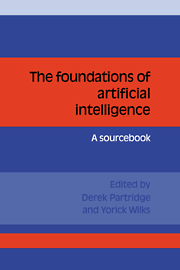Book contents
- Frontmatter
- Contents
- List of contributors
- Preface
- Acknowledgments
- 1 Introduction
- 2 The formal foundations of AI
- 3 Levels of theory
- 4 Programs and theories
- One small head: models and theories
- The nature of AI principles
- Artificial methodology meets philosophy
- 5 The role of representations
- 6 The role of programs in AI
- 7 Rational reconstruction as an AI methodology
- 8 Is AI special in regard to its methodology?
- 9 Does connectionism provide a new paradigm for AI?
- 10 The role of correctness in AI
- 11 Limitations on current AI technology
- 12 Annotated bibliography on the foundations of AI
- Index of names
One small head: models and theories
Published online by Cambridge University Press: 03 May 2010
- Frontmatter
- Contents
- List of contributors
- Preface
- Acknowledgments
- 1 Introduction
- 2 The formal foundations of AI
- 3 Levels of theory
- 4 Programs and theories
- One small head: models and theories
- The nature of AI principles
- Artificial methodology meets philosophy
- 5 The role of representations
- 6 The role of programs in AI
- 7 Rational reconstruction as an AI methodology
- 8 Is AI special in regard to its methodology?
- 9 Does connectionism provide a new paradigm for AI?
- 10 The role of correctness in AI
- 11 Limitations on current AI technology
- 12 Annotated bibliography on the foundations of AI
- Index of names
Summary
And still they gazed, and still the wonder grew, That one small head could carry all he knew.
Goldsmith's rustics were quite right about the village schoolmaster, of course, well in advance of their time and, apparently, of Goldsmith. But perhaps the time has come for less of such gazing, by AI researchers in particular, and more attention to their proper business. I am sure, for reasons I shall try to make clear, that the present situation, where much new work in AI is immediately proposed as new ‘model of the human brain or behaviour’, is an undesirable one.
This is a philosophical discussion about AI rather than a practical one; and intended to remind some AI researchers of standard uses of the words ‘model’ and ‘theory’ that they may have forgotten, and to explore some of the terminological consequences of a less liberal approach to these words than is the current fashion within AI.
Since it is a philosophical discussion, it is not intended to criticize any form of activity, or to suggest that it should not be carried out. It is concerned with how such work should be described, in the sense of what its ultimate subject matter is, and that such descriptions should be both revealing and consistent, and above all not misleading. I take it for granted in what follows that such questions are not “mere matters of words” or convention, and that it is no defence at any point to say that one can use the words ‘theory’ and ‘model’ to mean whatever one chooses.
- Type
- Chapter
- Information
- The Foundations of Artificial IntelligenceA Sourcebook, pp. 121 - 134Publisher: Cambridge University PressPrint publication year: 1990
- 3
- Cited by

